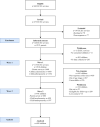Longitudinal effects of dog ownership, dog acquisition, and dog loss on children's movement behaviours: findings from the PLAYCE cohort study
- PMID: 38287372
- PMCID: PMC10826268
- DOI: 10.1186/s12966-023-01544-9
Longitudinal effects of dog ownership, dog acquisition, and dog loss on children's movement behaviours: findings from the PLAYCE cohort study
Abstract
Introduction: Regular physical activity is important for children's physical and mental health, yet many children do not achieve recommended amounts of physical activity. Dog ownership has been associated with increased physical activity in children, however, there have been no longitudinal studies examining this relationship. This study used data from the Play Spaces and Environments for Children's Physical Activity (PLAYCE) cohort study to examine the longitudinal effects of dog ownership status on children's movement behaviours.
Methods: Change in dog ownership from preschool (wave 1, age 2-5) to fulltime school (wave 2, age 5-7) was used as a natural experiment with four distinct dog ownership groups: continuing non-dog owners (n = 307), continuing dog owners (n = 204), dog acquired (n = 58), and dog loss (n = 31; total n = 600). Daily movement behaviours, including physical activity, sedentary time, sleep, and screen time, were measured using accelerometry and parent-report surveys. Differences between groups over time and by sex were tested using linear mixed effects regression models.
Results: Girls who acquired a dog increased their light intensity activities and games by 52.0 min/day (95%CI 7.9, 96.0) and girls who lost a dog decreased their light intensity activities and games by 62.1 min/day (95%CI -119.3, -4.9) compared to no change among non-dog owners. Girls and boys who acquired a dog increased their unstructured physical activity by 6.8 (95%CI 3.2, 10.3) and 7.1 (95%CI 3.9, 10.3) occasions/week, compared to no changes among non-dog owners. Girls and boys who lost a dog reduced their unstructured physical activity by 10.2 (95%CI -15.0, -5.3) and 7.7 (95%CI -12.0, -3.5) occasions/week. Girls who lost a dog decreased their total physical activity by 46.3 min/day (95%CI -107.5, 14.8) compared to no change among non-dog owners. Continuing dog ownership was typically not associated with movement behaviours. Dog ownership group was not associated with changes in sleep and had mixed associations with screen time.
Conclusion: The positive influence of dog ownership on children's physical activity begins in early childhood and differs by child sex. Further research should examine the specific contributions dog-facilitated physical activity makes to children's overall physical activity, including the intensity and duration of dog walking and play.
Keywords: Children; Cohort; Dog acquisition; Dog loss; Dog ownership; Longitudinal; Physical activity; Preschool.
© 2024. The Author(s).
Conflict of interest statement
None to declare.
Figures
Similar articles
-
Association between preschooler movement behaviours, family dog ownership, dog play and dog walking: Findings from the PLAYCE study.Prev Med Rep. 2022 Feb 28;26:101753. doi: 10.1016/j.pmedr.2022.101753. eCollection 2022 Apr. Prev Med Rep. 2022. PMID: 35251916 Free PMC article.
-
Effects of dog ownership on children's social-emotional development: findings from the PLAYCE cohort study.Pediatr Res. 2024 Nov 19. doi: 10.1038/s41390-024-03721-3. Online ahead of print. Pediatr Res. 2024. PMID: 39558121
-
Understanding the relationship between dog ownership and children's physical activity and sedentary behaviour.Pediatr Obes. 2013 Oct;8(5):392-403. doi: 10.1111/j.2047-6310.2012.00113.x. Epub 2012 Dec 13. Pediatr Obes. 2013. PMID: 23239579
-
Dog ownership and physical activity: a review of the evidence.J Phys Act Health. 2013 Jul;10(5):750-9. doi: 10.1123/jpah.10.5.750. Epub 2012 Sep 18. J Phys Act Health. 2013. PMID: 23006510 Review.
-
Family Dog Ownership and Youth Physical Activity Levels: A Scoping Review.Curr Sports Med Rep. 2022 Jan 1;21(1):18-27. doi: 10.1249/JSR.0000000000000927. Curr Sports Med Rep. 2022. PMID: 35018895
Cited by
-
Investigation of dog ownership and physical activity on weekdays and weekends using longitudinal data from the SOEP Cohort.Sci Rep. 2024 Oct 29;14(1):26007. doi: 10.1038/s41598-024-77231-x. Sci Rep. 2024. PMID: 39472735 Free PMC article.
References
-
- Poitras VJ, Gray CE, Borghese MM, Carson V, Chaput JP, Janssen I, et al. Systematic review of the relationships between objectively measured physical activity and health indicators in school-aged children and youth. Appl Physiol Nutr Metab. 2016;41(6 S3):S197–S239. doi: 10.1139/apnm-2015-0663. - DOI - PubMed
-
- World Health Organization . Motion for your mind: Physical activity for mental health promotion, protection and care. Copenhagen: World Health Organization; 2019.
-
- World Health Organization . WHO guidelines on physical activity and sedentary behaviour. Geneva: World Health Organization; 2020. - PubMed
MeSH terms
Grants and funding
LinkOut - more resources
Full Text Sources




